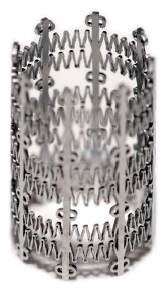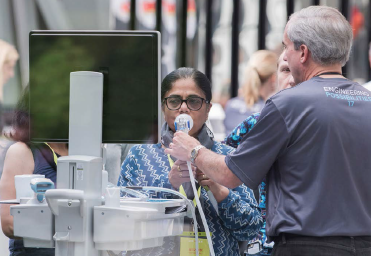Draper R&D Uses Technology to Solve Unmet Healthcare Needs
Trend Watch: Health technology is providing quicker, safer solutions for disease management and care.
Draper, a nonprofit research and development company focused on advanced technological solutions, has designed the first pediatric heart valve that’s designed to grow with a child.  Currently, there are no heart valve prosthetics on the market designed specifically for young children. Instead, children typically undergo three to five major surgeries before adulthood to replace valves that fail or they outgrow. Despite more than 50 valve designs in the past 40 years, the need for a pediatric heart valve only recently has been addressed.
Currently, there are no heart valve prosthetics on the market designed specifically for young children. Instead, children typically undergo three to five major surgeries before adulthood to replace valves that fail or they outgrow. Despite more than 50 valve designs in the past 40 years, the need for a pediatric heart valve only recently has been addressed.
The design of Draper’s pediatric heart valve (PHV) allows it to “grow" with the child, with at least a two-fold diameter change. The initial goal is to serve the most critical unmet need, which are children as young as infants through age 6, who require valve diameters less than 15 millimeters, as opposed to 18 to 30 millimeters for adults.
The engineers at Draper, in consultation with Boston Children’s Hospital, produced two promising design concepts, along with the computational models of the stent designs, and fabricated and tested the first-generation prototype. Draper hopes to complete ex vivo testing and design revision before moving into a growing animal model for proof-of-concept of function.
In other Draper news, the company is developing a breath-based test for invasive aspergillosis (IA) in collaboration with Brigham and Women’s Hospital (BWH) in Boston. The breath capture and analysis system is producing favorable results during initial clinical testing, a promising development for clinicians who want to shorten the time-to-diagnosis for IA.
Kenneth Markoski, a member of Draper’s technical staff, is working collaboratively with Sophia Koo, M.D., a physician in BWH’s division of infectious diseases, who is piloting the device in a clinical setting.
Mr. Markoski and his colleagues developed the novel device called the microAnalyzer that uses a differential mobility spectrometry (DMS) sensor, coupled with other technologies, to identify biomarkers in a patient’s breath samples that are indicative of disease or ailments.
Draper’s microAnalyzer is a portable device that can fit on a hospital cart for immediate access at the point-of-care. Smaller, less complex and less expensive than a mass spectrometer, the microAnalyzer performs similar high-quality chemical measurements immediately. The device, which couples DMS technology with a preconcentrator and a miniature fast gas chromatography column, features a tunable ion filter that can be set to reject interferents and select biomarkers of interest. The result is that the microAnalyzer can detect trace vapors as low as a few parts per trillion.
Researchers Take Aim at Endometrial Cancer with Nanoparticles
 At the University of Iowa (UI) College of Pharmacy, researchers are working to improve treatment methods for a particularly aggressive form of endometrial cancer. For the first time, researchers combined traditional chemotherapy with a relatively new cancer drug that attacks chemo-resistant tumor cells, loaded both into tiny nanoparticles, and created an extremely selective and lethal cancer treatment.
At the University of Iowa (UI) College of Pharmacy, researchers are working to improve treatment methods for a particularly aggressive form of endometrial cancer. For the first time, researchers combined traditional chemotherapy with a relatively new cancer drug that attacks chemo-resistant tumor cells, loaded both into tiny nanoparticles, and created an extremely selective and lethal cancer treatment.
For decades, the standard therapy for type II endometrial cancer has been chemotherapy and radition, and the possibility of a new treatment that is both highly selective and highly effective is generating excitement.
In recent years, there has been increased interest in using nanoparticles to treat cancer, in large part because of their small size. Tumors grow quickly, and the blood vessels they create to feed their growth are defective and full of holes.
Nanoparticles are small enough to slip through the holes, thereby allowing them to specifically target tumors.
Researchers from the University of Iowa loaded nanoparticles with two cancer drugs — paclitaxel and nintedanib — and injected them into lab mice with type II endometrial cancer. The super-lethal nanoparticles reduced tumor growth and extended survival rates.
The new treatment could mean improved survival rates for the roughly 6,000 U.S. women diagnosed with type II endometrial cancer every year and also represents an important step in the development of targeted cancer therapies.
Results of the three-year lab study were published in the journal Nature Nanotechnology.
“In this particular study, we took on one of the biggest challenges in cancer research, which is  tumor targeting," says Kareem Ebeid, a UI pharmacy science graduate student and lead researcher on the study. “And for the first time, we were able to combine two different tumor-targeting strategies and use them to defeat deadly type II endometrial cancer. We believe this treatment could be used to fight other cancers, as well."
tumor targeting," says Kareem Ebeid, a UI pharmacy science graduate student and lead researcher on the study. “And for the first time, we were able to combine two different tumor-targeting strategies and use them to defeat deadly type II endometrial cancer. We believe this treatment could be used to fight other cancers, as well."
Wound Assessment Tool Predicts Presence of Bacteria 100% of the Time
In clinical studies, a device called MolecuLight i:X has shown the ability to improve healing rates, detect subsurface bacterial infestations, and spot overall high levels of bacteria. The device allows clinicians to spot bacteria directly on the wound using fluorescence visualization that doesn’t require the use of any contrast agent. The Journal of Wound Care published a report, “Point-of-care fluorescence imaging predicts the presence of pathogenic bacteria in wounds: a clinical study," that demonstrated that red fluorescence observed on MolecuLight i:X images of 60 wounds predicted the presence of bacteria 100% of the time.
The MolecuLight i:X assesses the bacterial burden, measures the wound area, and documents results in a variety of ways. Additionally, it can help guide where to swab the wound to best sample it for bacteria.
Most wound assessment happens visually, typically without being able to spot most bacterial loads. Swabs are used to identify bacteria, and even that can be a hit and miss, as a lot of wounds have areas that are less infected than others. The MolecuLight i:X is used in a darkened room while it illuminates the wound using its special blacklight, while other images can be acquired with the room lights on.
In clinical studies, the MolecuLight i:X has already shown the ability to improve healing rates, detect subsurface bacterial infestations, and spot overall high levels of bacteria.
MolecuLight is a privately owned, Canadian medical imaging company with a product roadmap that includes applications in oncology.
Smartphone Case Offers Blood Glucose Monitoring
Engineers at the University of California San Diego have developed a smartphone case and app that will make it easier for patients to record and track their blood glucose readings wherever they are.
The device, called GPhone, is a new proof-of-concept portable glucose sensing system developed by Mercier, nanoengineering professor Joseph Wang, and their colleagues at the UC San Diego Jacobs School of Engineering. A 3D-printed case fits over a smartphone and has a permanent, reusable sensor on one corner. The second part consists of small, one-time use, enzyme-packed pellets that magnetically attach to the sensor. The pellets are housed inside a 3D-printed stylus attached to the side of the smartphone case. To run a test, the user would first take the stylus and dispense a pellet onto the sensor — this step activates the sensor. The user would then drop a blood sample on top. The sensor measures the blood glucose concentration, and wirelessly transmits the data via Bluetooth to a custom-designed Android app that displays the numbers on the smartphone screen. The test takes about 20 seconds. Afterward, the used pellet is discarded, deactivating the sensor until the next test.
The team envisions one day integrating glucose sensing directly into a smartphone rather than a case. Some next steps include testing on actual blood samples and minimizing sample volumes.
The current prototype uses at least a dozen drops of sample per test, so researchers aim to cut that down to an amount that’s normally extracted from a finger prick. They also plan to include a function in the app that sends phone alerts reminding users to check their blood sugar.
Timestrip Smart Indicators Help Avoid Missed Vaccinations
A specially developed smart indicator technology from Timestrip is being adopted in developing countries where missed vaccinations are common. Working with the Trust for Vaccines & Immunization (TVI), a nonprofit organization, Timestrip technology has been used to create a set of Vaccine Indicator Reminder (VIR) bands that are worn by newborn babies to remind mothers when vaccinations are due.
The operation of the devices is based on predictable chemical processes, so no moving parts or electronics are involved, thereby providing a simple, failsafe operation that is easy to use. Parents need to just press on the bands lightly to activate them. An irreversible chemical process, based on a special food grade dye, then provides a highly visible countdown to the next vaccine due date.
Timestrip indicators are capable of monitoring time from one hour to two years, and temperatures from -20 degrees Celsius to 38 degrees Celsius.
Three different color bands are used: at birth, and at a 6-, 10-, and 14-week immunization schedule. The infant receives the first VIR (yellow) band after receiving the birth dose of vaccines, and two more bands at 6 (purple) and 10 (aqua) week visits. Once the infants receive the fourth dose of vaccines at 14 weeks of age, they are protected against nine vaccine preventable diseases, ensuring their survival and protection from lifelong disability.
“The environmentally friendly, low-cost and widely used Timestrip technology has made it possible for the VIR band to be tested in low income communities in Pakistan and Nigeria," says Dr. Noor Sabah Rakhshani from TVI. “We are taking small but very important steps in our quest to protect children from vaccine preventable illnesses across Pakistan and around the world"."
Dr. Rakhshani created the concept of the smart bands, and she was the recipient of a Bill & Melinda Gates Foundation Grand Challenges Explorations Award to bring the idea to fruition.
Timestrip is an agile technology business that designs and manufactures time and temperature indicators. (PV)


















